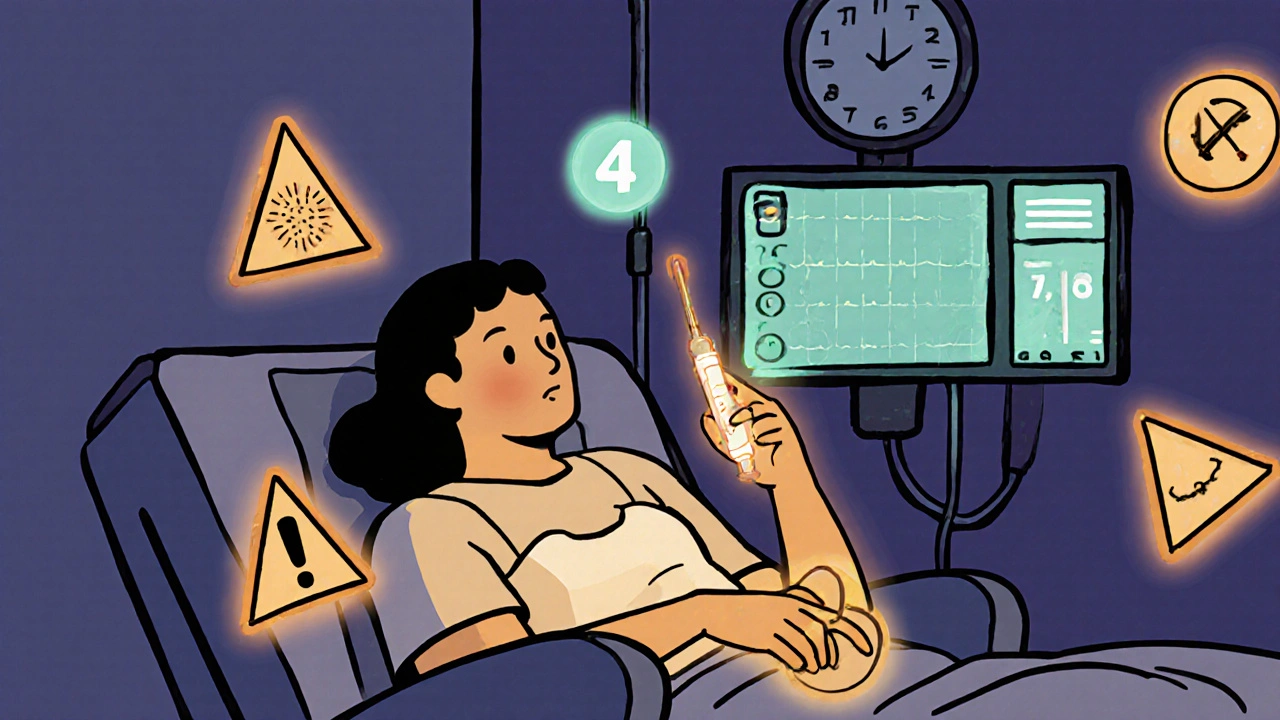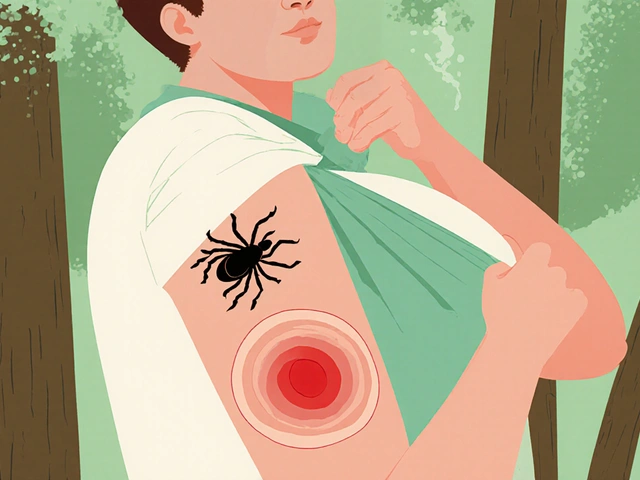
Desensitization Eligibility Checker
Is desensitization right for you?
This tool helps determine if desensitization may be appropriate based on your specific allergy situation. Results should always be reviewed by a qualified allergist.
When a life-saving drug makes you break out in hives, swell up, or go into anaphylaxis, what do you do? Stop taking it? But what if that’s the only drug that works? This isn’t a hypothetical. Every year, thousands of patients face this exact dilemma - especially those needing antibiotics for resistant infections or chemotherapy for cancer. The answer isn’t avoidance. It’s desensitization.
What Desensitization Actually Does
Desensitization isn’t curing an allergy. It’s temporarily turning off your body’s overreaction to a drug. Think of it like resetting a smoke alarm that’s going off because of toast - you’re not removing the alarm, you’re just making it ignore the smell for a few hours. Once the drug is out of your system, the allergy comes back. That’s why you need to repeat the process every time you take the medication.
This technique was first developed in the 1960s at the National Institutes of Health and later refined by Dr. Mariana Castells at Brigham and Women’s Hospital. Today, it’s a standard tool in allergy and immunology clinics. Success rates? Near perfect - 95% to 100% for immediate reactions like hives, wheezing, or low blood pressure. For patients who’ve been told they can’t take penicillin, cephalosporins, or chemo drugs like paclitaxel, desensitization isn’t a last resort. It’s often the only way to get the treatment they need.
When Doctors Recommend It
Desensitization isn’t for every allergic reaction. It’s only used when:
- There’s no safe or effective alternative drug available
- The drug is critical - like a first-line antibiotic for a life-threatening infection or a chemotherapy drug with proven survival benefits
- The reaction was an immediate hypersensitivity - meaning symptoms came on within minutes to an hour after taking the drug
It’s rarely used for delayed reactions like rashes that show up days later. Those are often T-cell mediated, and desensitization doesn’t work well for them. In fact, for severe skin reactions like Stevens-Johnson syndrome, it’s outright dangerous and banned by the American Academy of Allergy, Asthma & Immunology.
Take penicillin allergies. Up to 10% of people say they’re allergic. But 90% of them aren’t truly allergic - they had a rash as a kid and were labeled allergic forever. For those who are truly allergic, desensitization lets them take penicillin safely. One study at Brigham and Women’s treated 42 patients with confirmed penicillin allergies. All completed their full antibiotic course. None had anaphylaxis. Only 8% had mild flushing or itching.
Same goes for chemotherapy. About 1 in 5 cancer patients develop an allergic reaction to drugs like paclitaxel or carboplatin. Premedication with antihistamines and steroids fails in about 10% of those cases. Desensitization? Success rate above 95%.
The Two Main Types of Protocols
There are two ways to do this: rapid and slow.
Rapid Drug Desensitization (RDD) is for immediate reactions. It’s done in a hospital or clinic with full monitoring. The process starts with a tiny dose - 1/10,000th of the full therapeutic amount. Then, every 15 minutes, the dose doubles. It takes 4 to 6 hours to reach the full dose. This is the standard for IV antibiotics, chemo drugs, and monoclonal antibodies. Most protocols use 12 steps. Each dose is carefully diluted and given slowly under watchful eyes.
Slow Drug Desensitization (SDD) is for delayed reactions - like skin rashes that appear 24 to 72 hours after taking the drug. These are harder to treat. There’s no universal protocol. Dosing intervals can be hours or even days apart. Aspirin desensitization, for example, can take 2 to 3 days. Patients start with a few milligrams, then slowly increase by tiny amounts over time. It’s done orally and requires daily visits. Success rates are lower - around 60% to 70% - and it’s only considered when no other option exists.
What Happens During the Procedure
It’s not a quick trip to the pharmacy. Desensitization requires a medical team, specialized equipment, and constant monitoring.
Here’s what you’ll see in the room:
- Continuous blood pressure monitoring
- Pulse oximetry to track oxygen levels
- ECG for heart rhythm
- IV access ready for emergency drugs
- Epinephrine, antihistamines, and steroids on standby
A trained allergist or immunologist must be present. Nurses monitor the patient between doses. Vital signs are checked before every new dose. If a reaction happens - even mild itching or a slight drop in blood pressure - the dose is paused. Sometimes it’s lowered. Sometimes they wait. Sometimes they stop.
Most reactions are mild. Flushing, itching, or a slight headache. Severe reactions like anaphylaxis happen in fewer than 2% of properly managed cases. But if the team isn’t trained, or the facility isn’t equipped, that number jumps. One study found that when community clinics tried this without proper protocols, complication rates tripled.
Why It Beats Alternatives
Some doctors try to avoid desensitization by switching drugs or giving premedication.
But here’s the problem: alternatives often don’t work as well.
For example, if you’re allergic to penicillin, you might be given vancomycin or clindamycin instead. But those drugs are less effective against certain infections. In one study, 15% to 20% of patients treated with substitutes still had treatment failure because the alternatives didn’t kill the bacteria as well. Plus, they’re more likely to cause other side effects like C. diff infections.
Premedication - giving antihistamines and steroids before the drug - sounds like a good idea. But it fails in about 10% of chemotherapy cases. That means 1 in 10 patients still have a reaction, even with premeds. Desensitization cuts that risk to under 5%.
And then there’s the cost. Substitutes are often more expensive. Vancomycin costs 10 times more than penicillin. Some chemo alternatives are hundreds of dollars per dose. Desensitization? It’s a one-time procedure that lets you use the cheaper, more effective drug.
The Hidden Challenges
It’s not all smooth sailing. Desensitization has real barriers.
First, it’s time-consuming. The average IV desensitization takes 4.7 hours. Patients sit in a chair, hooked up to monitors, getting tiny doses over and over. It’s exhausting. Many report anxiety - even if they know it’s safe, the fear of a reaction is real.
Second, it’s resource-heavy. Each procedure needs 4.2 nursing hours and 1.8 physician hours. That’s a full workday for a team. Smaller hospitals can’t afford it. In community clinics, only 35% of eligible patients get desensitized. In top academic centers? Over 85%.
Third, mistakes happen. A 2020 study found that 8% of first-time attempts had dosing errors - wrong dilution, wrong timing. That’s why standardized kits and electronic checklists are now required in most major hospitals. Simulation training has cut protocol errors from 22% to under 5%.
And then there’s the financial side. Medicare and Medicaid cover only about 60% of the actual cost. That means hospitals lose money doing it. Many avoid it unless the patient is critically ill.

Who Shouldn’t Try It
Desensitization isn’t for everyone. It’s strictly off-limits for:
- Patients with a history of Stevens-Johnson syndrome or toxic epidermal necrolysis
- Those with severe delayed rashes that involved blistering or mucous membrane damage
- People with uncontrolled asthma or unstable heart conditions
- Patients who’ve had a prior fatal reaction
Even for those who qualify, it’s not guaranteed. For delayed reactions, success rates drop to 30% to 40%. In those cases, doctors will usually look for other options - even if they’re less ideal.
What’s Next for Desensitization
The field is changing fast.
In 2023, the American Academy of Allergy, Asthma & Immunology released the first national standard for desensitization protocols. Before that, every hospital had its own rules. Now, there’s one clear guideline.
Researchers are also testing biomarkers. A 2023 Lancet study showed that a simple blood test measuring basophil activation can predict with 89% accuracy who will respond to desensitization. That means fewer trials, fewer risks.
And soon, home-based desensitization may become a reality. Early trials with stable patients show 92% success with supervised home protocols. Imagine being able to take your next dose of chemo at home - no hospital stay, no 5-hour wait.
Long-term, experts believe genetic and immune profiling will guide who needs desensitization and which protocol to use. Within five years, we may be able to say: ‘Your immune system responds this way - here’s exactly how we’ll safely give you this drug.’
Real Stories, Real Outcomes
One patient, u/PenicillinWarrior on Reddit, spent 20 years avoiding penicillin after a childhood rash. When he developed osteomyelitis, his doctor said only penicillin would work. He went through a 4-hour rapid desensitization. He finished his antibiotics. No reaction. He’s now pain-free.
An oncology patient described desensitization as ‘life-saving.’ Without it, she would have had to switch to a chemo drug with lower survival rates. After the procedure, she completed her full treatment. Her cancer went into remission.
But not all stories are perfect. One patient said her hospital didn’t have the right dilution kits. It took three tries before they got the protocol right. That’s why training and standardization matter.
For the right patient, desensitization isn’t a gamble. It’s a lifeline. For the wrong patient - or if done without expertise - it’s a danger.
The bottom line? If you’re told you can’t take a drug because of an allergy, ask: ‘Is desensitization an option?’ Don’t assume it’s too risky. Don’t assume it’s not available. Ask for an allergy specialist. It might be the difference between treatment and no treatment.
Can you desensitize to any medication?
No. Desensitization works best for immediate hypersensitivity reactions - like hives, swelling, or anaphylaxis that happen within minutes to an hour after taking the drug. It’s commonly used for antibiotics (like penicillin), chemotherapy drugs (like paclitaxel), and monoclonal antibodies. It doesn’t work well for delayed reactions like rashes that appear days later, and it’s strictly avoided for severe skin reactions like Stevens-Johnson syndrome.
How long does desensitization last?
The tolerance is temporary. Once the drug is cleared from your body - usually within 24 to 48 hours - your immune system returns to its original state. That means you need to repeat the full desensitization process every time you need the drug. It’s not a cure. It’s a temporary reset.
Is desensitization safe?
When done correctly in a hospital or allergy clinic with trained staff and full monitoring, it’s very safe. Severe reactions occur in less than 2% of cases. Most side effects are mild - flushing, itching, or a headache. But if done in a non-specialized setting without proper equipment, complication rates can triple. Always insist on an allergist or immunologist overseeing the procedure.
What’s the difference between desensitization and premedication?
Premedication means giving antihistamines and steroids before the drug to reduce the chance of a reaction. It’s a preventive measure. Desensitization is a process that changes how your immune system responds - you’re gradually exposing your body to increasing doses until it stops reacting. Premedication fails in about 10% of chemotherapy cases. Desensitization succeeds in over 95%.
Can I do desensitization at home?
Not yet for most people. All current standard protocols require hospital or clinic supervision. But early-phase trials are testing home-based desensitization for stable patients who’ve already completed one successful procedure. These trials show 92% success rates. If approved, this could make the process much more accessible - but it’s still experimental.
How do I find a doctor who does desensitization?
Start by asking your primary doctor or oncologist for a referral to an allergist or immunologist. Desensitization is only performed by specialists trained in allergy and immunology. Most major hospitals and academic medical centers have these services. Community clinics often don’t. If you’re told it’s not available, ask if they can transfer you to a center that does. Don’t accept ‘no’ without asking for a specialist opinion.




Shannon Amos
November 26, 2025 AT 21:48So you’re telling me I can literally trick my body into not killing me over penicillin? 🤯 Like, I’ve been avoiding it since third grade because I got a rash after amoxicillin… turns out I’m just a dramatic potato. This is wild.
stephen riyo
November 28, 2025 AT 00:17Wait… wait… so if I’m allergic to chemo, I just… slowly drink it? Like, one drop at a time? That’s not science-that’s a horror movie. And why is no one talking about how this costs a fortune? Hospitals lose money doing this, so they’ll only do it if you’re dying… which is kind of the point, but also… yikes.
Jaspreet Kaur
November 29, 2025 AT 17:56Life is a paradox isn’t it? We fear what saves us. The same immune system that protects us from infection becomes our enemy when it misreads a molecule as a threat. Desensitization isn’t just medicine-it’s a quiet rebellion against the body’s overzealous bureaucracy. We don’t cure the allergy-we negotiate with it. And isn’t that what all healing really is? A conversation with the self? No punctuation needed to feel that.
Gina Banh
December 1, 2025 AT 01:49Stop. This is the most important thing I’ve read all year. If you’ve been told you’re allergic to penicillin, get tested. 90% of you aren’t. And if you actually are? Demand desensitization. No more vancomycin. No more C. diff. No more being treated like a liability. This isn’t experimental-it’s standard. If your doctor doesn’t know this, fire them. Seriously. I’ve seen people die because they were given inferior drugs out of fear. Don’t be one of them.
Deirdre Wilson
December 1, 2025 AT 10:19So it’s like… your body’s smoke alarm is stuck on ‘TOAST FIRE’ but you just want pancakes? So you slowly wave a piece of bread under it until it’s like, ‘ohhhhhhh… that’s just toast. I’m chill now.’ I love this metaphor. I’m gonna use this at my next family dinner. My aunt thinks I’m allergic to ibuprofen because I sneezed once. This’ll blow her mind.
Damon Stangherlin
December 1, 2025 AT 15:16This is so cool. I had no idea this was even a thing. My sister’s a cancer survivor and she went through this for paclitaxel-she never talked about it much, just said ‘it was long but worth it.’ Now I get why. I’m gonna send this to my mom. She’s been avoiding antibiotics for years because of a rash she got in 1987. She’s 68 and still thinks she’s allergic. Maybe this can help her. Thanks for writing this.
Ryan C
December 1, 2025 AT 18:39Correction: The success rate for rapid desensitization is 95–100% for IgE-mediated reactions, not ‘immediate reactions’-which is a vague term. Also, the 2023 Lancet study used basophil activation testing (BAT), not ‘a simple blood test.’ And the home-based trials? Phase 2. Not approved. Don’t mislead people. Also, Stevens-Johnson is not ‘banned’-it’s a contraindication. Words matter. 😊
Dan Rua
December 3, 2025 AT 07:11Wow. This is exactly the kind of info we need more of. I’ve seen people avoid life-saving meds because of a label from 30 years ago. This post is a gift. I’m sharing it with my book club. Also, I’m gonna ask my allergist if my ‘sulfa allergy’ is real. I’ve been scared to take Bactrim for years. Maybe I’m just a myth. 😅
Mqondisi Gumede
December 4, 2025 AT 15:37You Americans think you invented everything. In South Africa we’ve been doing this since the 80s with TB drugs. No fancy NIH studies needed. Just common sense and a strong spine. You pay 10k for a 4-hour procedure? We give it in a township clinic with a fan and a prayer. Your system is broken. This isn’t innovation-it’s capitalism with a stethoscope.